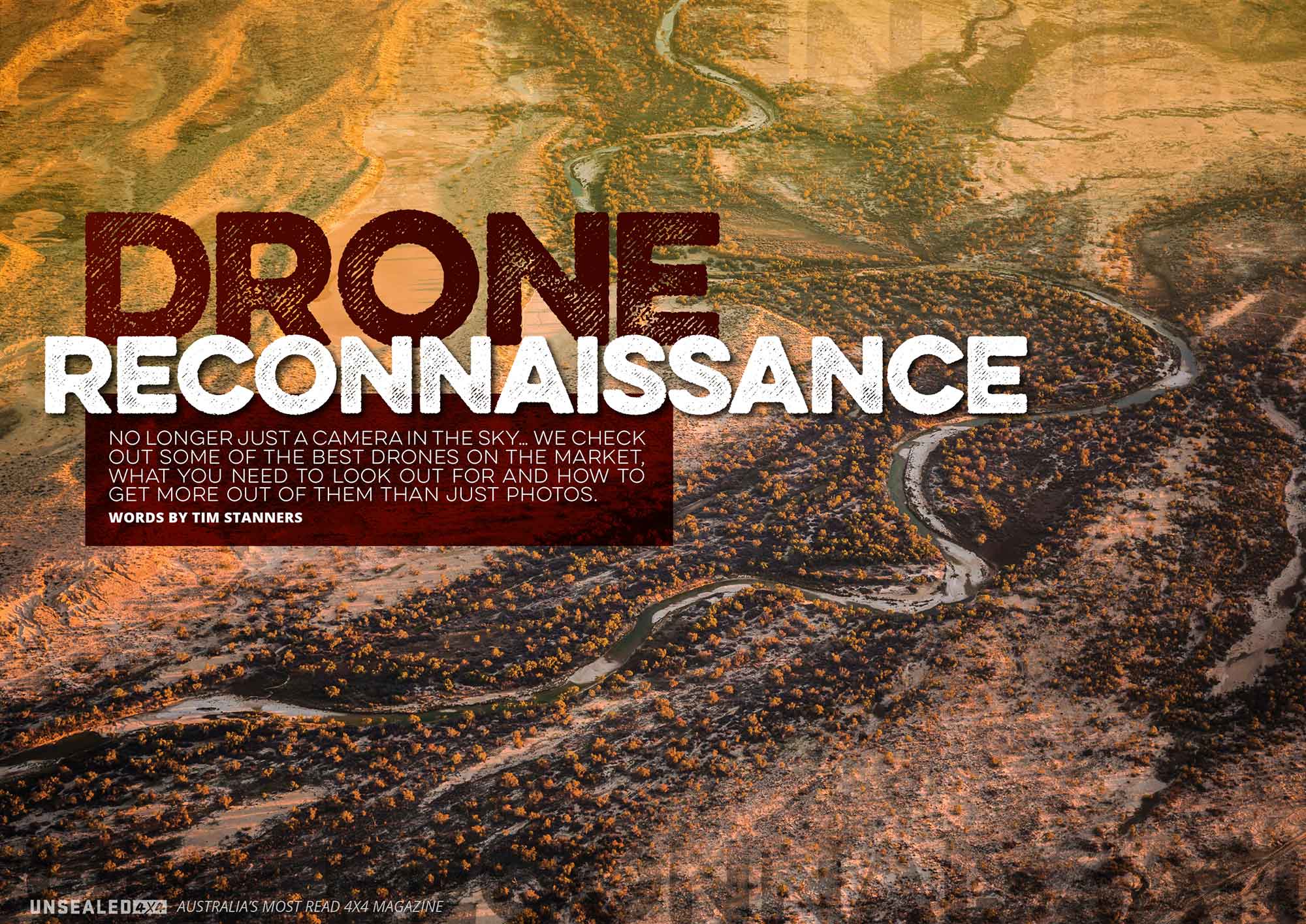No longer just a camera in the sky… we check out some of the best drones on the market, what you need to look out for and how to get more out of them than just photos.
If, like me, you love your gadgets, then chances are you’ve already got one of the many and varied camera drones. But other than taking aerial photos, what do you need to know about drones, aerial imagery and what other uses will give you the best excuse to go and buy yourself one?
Read this story on our Unsealed 4X4 magazine platform, complete with images HERE.
Drones, Quads, whatever you want to call them, unmanned aerial vehicles or UAVs have opened up a whole new world of excitement and opportunity for people. Integrated with built-in cameras or the ability to attach aftermarket cameras, drones have become a big industry with sales skyrocketing and costs, well… coming down a little bit. Historically, quality drone imagery was limited to the very top end of town and it was really only dedicated photographers and other industry folk who could afford the drones and cameras necessary to take decent photos or video. Now however, new models directed more towards the mid range of pricing have allowed hobbyists to get into the game. Full 1080 HD video at 60 frames per second, up to 4K video as well as 12-14 megapixel photos are common among the many and varied drones on the market – allowing stunning imagery to be taken with the click of a controller button. Many come with ‘out of the box’ video preset functions which allow the drone to record a range of video styles such as the ‘Follow Me’ function – where the drone will sit comfortably behind a moving object while keeping that object in the centre of the video frame.
We’ve been running a couple of drones at Unsealed 4X4 for slightly different reasons though. Sure, they take magical imagery and video at a significantly reduced cost over a helicopter and photographer. But we’ve also been using them as part of our trip planning and decision-making processes. Whilst struggling with a wet and boggy track, we wanted to make sure we didn’t make more of a mess than was necessary; and, uncertain of the track condition ahead, we stopped and sent the drone up to take a look. Then, just like the military, Unsealed 4X4 ‘drone reconnaissance’ was born. We now use this regularly to ensure a ‘tread lightly’ approach whereby we can pick the best lines or even find alternate tracks to ensure sustainable and ethical off-road touring and 4X4 adventure… and the best part about it is we can record our adventure while we’re doing it.
The Legalities and CASA
Be warned! There are laws which affect you as soon as your drone lifts off the ground.
Let’s face it: With drones utilising technology that can give them literally kilometres of range, all the while streaming live video back to the controller. However, CASA stipulates that drones do need to be kept within line-of-sight at all times.
Drones also need to be kept at least 30m away from boats, vehicles, buildings or people.
Voyeurs beware – you cannot fly a drone directly over any populous area. Be it a beach, backyard, sports oval or other populated area. Drones must be kept below 120m while being flown in any controlled airspace which, incidentally, covers most cities and major towns throughout the country. If you’re within 5.5km of an airfield, forget it!
CASA also stipulates that ignorance of location is not a defence and it is therefore up to the individual to find out if restrictions apply to any area where a drone is intended to be flown … so be warned.
Additionally, there are restrictions on flying drones for commercial purposes without certification. We won’t bore you with them here, so for further information refer to casa.gov.au
The Most Popular: DJI Phantom 3
If you’re serious about drones, then you’ll have heard of the DJI Phantom. The Phantom has been around for a while and is now in its fourth incarnation with the Phantom 4 having just been released. The outgoing Phantom 3 has been hugely popular among hobbyists for its streamlined flight controls and simple features while delivering staggering video and stills photography. The only downside to the Phantom is the cost, although you can pick up earlier models at reasonable prices. Everything else works beautifully.
The Phantom comes with a built-in camera and has a flying time of just over 20 mins on one battery. Standard features include:
Up to 4K Video/12 MP Photo
Integrated 3-Axis Stabilisation Gimbal
Intelligent flight mode system with multiple flight functions including POI, way points, return to home, follow me, course lock and home lock as well as the standard free flight
GPS + GLONASS Positioning System
The Phantom integrates with the controller through the DJI app on your phone or tablet device and has built-in safety features through the pre-flight GPS lock, limiting the chance of an unexpected flyaway. If you’ve ever wanted to get into drone imagery, then we reckon you can’t go past the DJI Phantom.
Price: From $850 to $2,400
Catching Up Fast: 3D Robotics Solo
A big competitor to the Phantom, and looking like it’s come straight off the set of a Thunderbirds movie, is the 3D Robotics Solo. The Solo is an option for those who may already have a GoPro camera in the kit bag. Rather than the all-in-one concept of the DJI models, the Solo comes without a built-in camera and instead has a GoPro-ready mount on a 3-axis gimbal.
Setting up smooth aerial shots with the Solo is a breeze through its range of GPS-reliant ‘Smart Shot’ settings. The smart shots are selected easily through the Solo app and include Cable Cam (which allows you to select two points and almost any track between these). The drone will then fly the course as if attached to an imaginary cable, while controlling the camera’s tilt and pan to produce a smooth, professional-looking video sequence.
Other Smart Shots include Orbit, Selfie and Follow. Likewise, each of these functions produces some pretty amazing video although the wider field of view of the GoPro ‘fish-eye’ style lens can create slightly distorted horizon imagery from the air. As with most ready-to-fly drones with a similar price point, the Solo comes standard with GPS locking and return-to-home button as well as two user-configurable buttons.
Streaming HD video straight to your phone or tablet via the Solo app allows simple unobstructed viewing and recording, as well as easy-to-control inflight adjustable camera settings.
With around 25 minutes of flight time on a single battery and a top speed of 88 km/h, the 3DR Solo is a nice choice for simplicity and ease of use… as long as you have a GoPro.
Price: Around $1,400 (without a camera)
The Parrot or the Bebop
The other popular drone in the category is the Parrot Bebop. The name and colour aside, we reckon this thing looks like a cross between a budgie and an old World War II Spitfire. You’ll pay around $1,500 for the full kit including the drone and the controller. However, there is the option of foregoing the expensive ‘Skycontroller’ and running the drone through a phone or tablet – reducing the cost by around $700.
Without the controller, the Bebop becomes a little more competitive when compared to the bigger two in the market as, in our view, it’s simply not as refined as the others. For around $800 for the drone itself, it does become a little more appealing however; and it will certainly give you some quality imagery through the built-in 14 megapixel fish-eye camera.
The Bebop does have a limited range without the Skycontroller; using only WiFi connectivity, the maximum range sits at around 250 metres. Using a phone or tablet, one cool feature of this drone is the ability to perform ‘stunt’ manoeuvres (flips, backflips and the like). We don’t really know why and you’ll probably get bored, but it is a caper the others can’t pull off.
Battery life is a little limited with just under 10 mins flight time per battery. The drone does ship with two batteries however, giving 15-20 mins flight time in total for what represents a cheaper reconnaissance drone.
Would we buy one? Maybe… but if we had the cash, we’d definitely go for one of the more refined models.
Words by Tim Stanners









